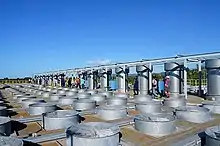Energy in East Timor
East Timor consumes 125 GWh of electricity per annum, an average of 95 kWh per person.[1] The country has about 270 MW of electricity capacity, 119 MW in the city of Hera.

Betano Power Station, powered by imported fuel oil

Map of East Timor with photovoltaic potential shaded; as can be seen, it is very high, especially near the coast.
Most of the energy infrastructure was destroyed by the Indonesian militias during the 1999 East Timorese crisis.[2] In 2005, the government identified the high price of electricity (US$0.20 per kWh) as a deterrent to development.[3][4] Gariuai Hydroelectric Plant is the country's only hydro plant, with a production capacity of 326 kW.[5] Many people rely on diesel generators.[6] A feasibility study of 2007–10 concluded that the country had huge potential for renewable energy.[7]
See also
Wikimedia Commons has media related to Energy in East Timor.
References
- Fund, International Monetary (July 26, 2005). East Timor: National Development Plan. International Monetary Fund. ISBN 9781451837315 – via Google Books.
- "Renewable energy in the Asia Pacific: a legal overview (3rd edition) - East Timor - Energy and Natural Resources - East Timor". www.mondaq.com.
- Beuman, Lydia M. (February 5, 2016). Political Institutions in East Timor: Semi-Presidentialism and Democratisation. Routledge. ISBN 9781317362128 – via Google Books.
- Cristalis, Irena (October 15, 2009). East Timor: A Nation's Bitter Dawn. Zed Books Ltd. ISBN 9781848134294 – via Google Books.
- "Gesto Energy | East Timor Renewable Energy Electrification Plan".
- Hill, Hal; Saldanha, Joao Mariano de Sousa (March 1, 2001). East Timor: Development Challenges for the World's Newest Nation. Institute of Southeast Asian Studies. ISBN 9789812301406 – via Google Books.
- Cionnaith, Rosie Nic. "'State-building is a good war, but this is a new struggle'". The Irish Times.
This article is issued from Wikipedia. The text is licensed under Creative Commons - Attribution - Sharealike. Additional terms may apply for the media files.